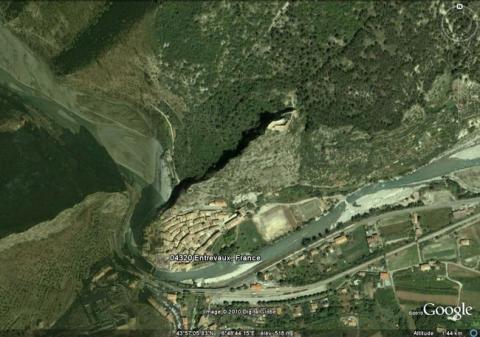Entrevaux
History and description
A site occupied since the time of the Celts, the town of Entrevaux only emerged under the Merovingians on the right bank of the Var. In the 10th century, the need to defend the town sparked its relocation to a site along the left bank and installation at the present-day spur. The town developed progressively and gained the status of a royal city under Francis I in 1542. This nomination was motivated by the services rendered by its residents to the Kingdom of France during the wars against Charles Quint, sovereign of Italy. The medieval fortifications and the castle built on top of the spur were also reinforced at this time. However, the first modern constructions would only get underway under Louis XIII. Richelieu had the urban wall reinforced and replaced the castle with the current citadel in 1624.In 1690, the war of the League of Augsburg and the Savoy threat prompted Vauban to reinforce the defences of Entrevaux. The engineer Antoine Niquet, head of the fortifications of Provence, was delegated to work on-site. The following year, Niquet acted to implement the projects of Vauban. He started by reinforcing the three gates of the town by the addition of drawbridges and towers to duplicate the ramparts at their levels. Subsequently, he constructed a hornwork in front of the porte d’Italie, which was the most vulnerable, and bastioned semi-circular towers without arches. Finally, he linked the citadel to the town by the construction of a road protected by walls and equipped with turrets. In 1692, Vauban constructed two additional towers on the urban wall: these two tours were vaulted, housed two or three floors, and were equipped to handle artillery.
In 1708-1709, the engineer of Langrune constructed two small forts, the fort Pandol and the fort Langrune, at the start of the protected road towards the fortress in order to reinforce the protection of the side of the town.
Current state
The set of ramparts and the citadel, as well as the protected road, protecting the link, still exist and have been entirely preserved. The ramparts are now a place for walking and medieval style fairs are regularly organised there. Transformed into barracks at the end of the 19th century and to a prison during the First World War, the task of the citadel today is exclusively tourism-related and it is open for visitors all year round.
Entrevaux
Entrevaux
43° 57' 9" N, 6° 48' 49" E
Type
urban wall and citadel
Engineers
Antoine Niquet, Sébastien le Prestre de Vauban, Hue de Langrune
Department
Alpes de Haute-Provence
Region
Provence-Alpes-Côte d'Azur
Bibliography
- BORNECQUE (R.), FAUCHERRE (N.), La route des fortifications dans les Alpes, Paris, 2006.
- BORNECQUE (R.), Vauban et les Alpes, Saint-Léger-Vauban, 1995.
- BORNECQUE (R.), « La fortification classique de montagne (à l’aide d’exemples pris dans les Alpes) » in Vauban et ses successeurs en Briançonnais, Paris, 1995, p.23-46.
- CROCHET (B.), RIVET (G.), Vauban et son héritage, Guide des forteresses à visiter, Rennes, 2014, p.75-76.
- Ouvrage collectif, Vauban et ses successeurs dans les Alpes de Haute-Provence, Paris, 1992.
![Antrevaux [Entrevaux], plan de 1693, dans Recueil des plans des places du Royaume, divisé par provinces, faits en l’an 1693, s. l., 1693, vol. 2, pl. 9, gallica.bnf.fr / Bibliothèque nationale de France. Antrevaux [Entrevaux], plan de 1693, dans Recueil des plans des places du Royaume, divisé par provinces, faits en l’an 1693, s. l., 1693, vol. 2, pl. 9, gallica.bnf.fr / Bibliothèque nationale de France.](/sites/default/files/styles/paragraphe_libre/public/images/plan_ancien-22.jpg?itok=0X0vHHjJ)
